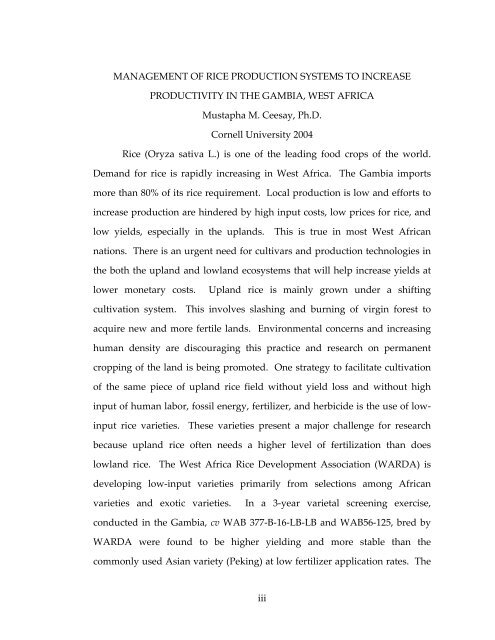Management of rice production systems to increase productivity
Management of rice production systems to increase productivity
Management of rice production systems to increase productivity
Create successful ePaper yourself
Turn your PDF publications into a flip-book with our unique Google optimized e-Paper software.
MANAGEMENT OF RICE PRODUCTION SYSTEMS TO INCREASE<br />
PRODUCTIVITY IN THE GAMBIA, WEST AFRICA<br />
Mustapha M. Ceesay, Ph.D.<br />
Cornell University 2004<br />
Rice (Oryza sativa L.) is one <strong>of</strong> the leading food crops <strong>of</strong> the world.<br />
Demand for <strong>rice</strong> is rapidly increasing in West Africa. The Gambia imports<br />
more than 80% <strong>of</strong> its <strong>rice</strong> requirement. Local <strong>production</strong> is low and efforts <strong>to</strong><br />
<strong>increase</strong> <strong>production</strong> are hindered by high input costs, low p<strong>rice</strong>s for <strong>rice</strong>, and<br />
low yields, especially in the uplands. This is true in most West African<br />
nations. There is an urgent need for cultivars and <strong>production</strong> technologies in<br />
the both the upland and lowland eco<strong>systems</strong> that will help <strong>increase</strong> yields at<br />
lower monetary costs. Upland <strong>rice</strong> is mainly grown under a shifting<br />
cultivation system. This involves slashing and burning <strong>of</strong> virgin forest <strong>to</strong><br />
acquire new and more fertile lands. Environmental concerns and increasing<br />
human density are discouraging this practice and research on permanent<br />
cropping <strong>of</strong> the land is being promoted. One strategy <strong>to</strong> facilitate cultivation<br />
<strong>of</strong> the same piece <strong>of</strong> upland <strong>rice</strong> field without yield loss and without high<br />
input <strong>of</strong> human labor, fossil energy, fertilizer, and herbicide is the use <strong>of</strong> low‐<br />
input <strong>rice</strong> varieties. These varieties present a major challenge for research<br />
because upland <strong>rice</strong> <strong>of</strong>ten needs a higher level <strong>of</strong> fertilization than does<br />
lowland <strong>rice</strong>. The West Africa Rice Development Association (WARDA) is<br />
developing low‐input varieties primarily from selections among African<br />
varieties and exotic varieties. In a 3‐year varietal screening exercise,<br />
conducted in the Gambia, cv WAB 377‐B‐16‐LB‐LB and WAB56‐125, bred by<br />
WARDA were found <strong>to</strong> be higher yielding and more stable than the<br />
commonly used Asian variety (Peking) at low fertilizer application rates. The<br />
iii
















